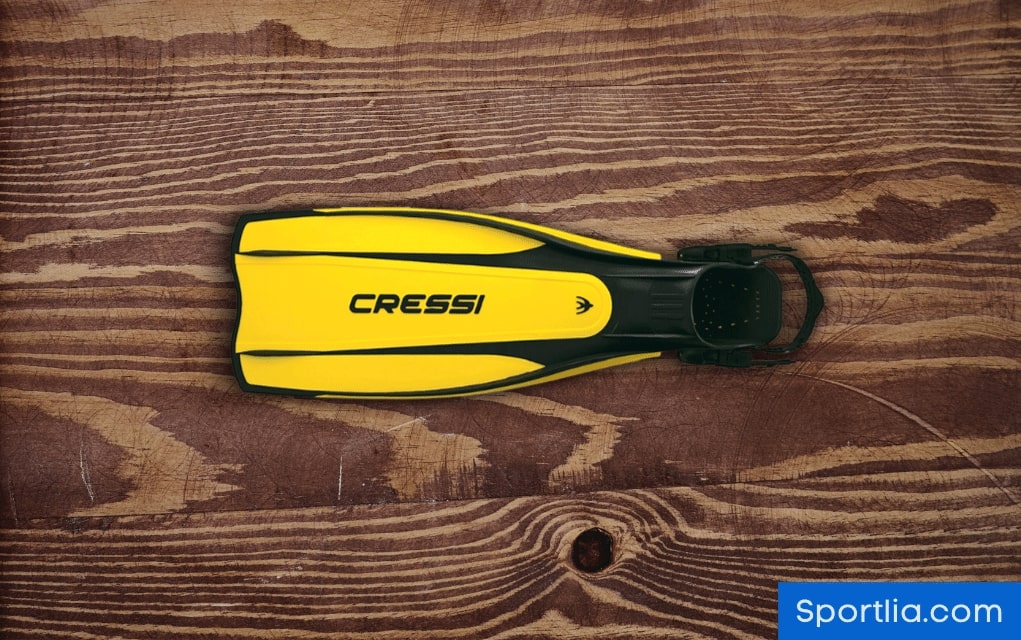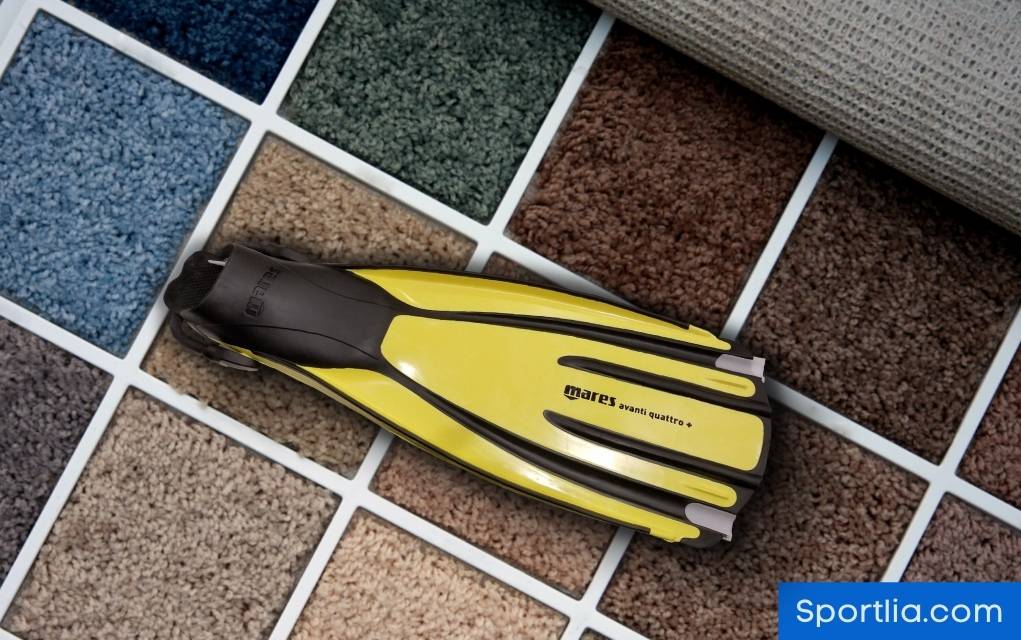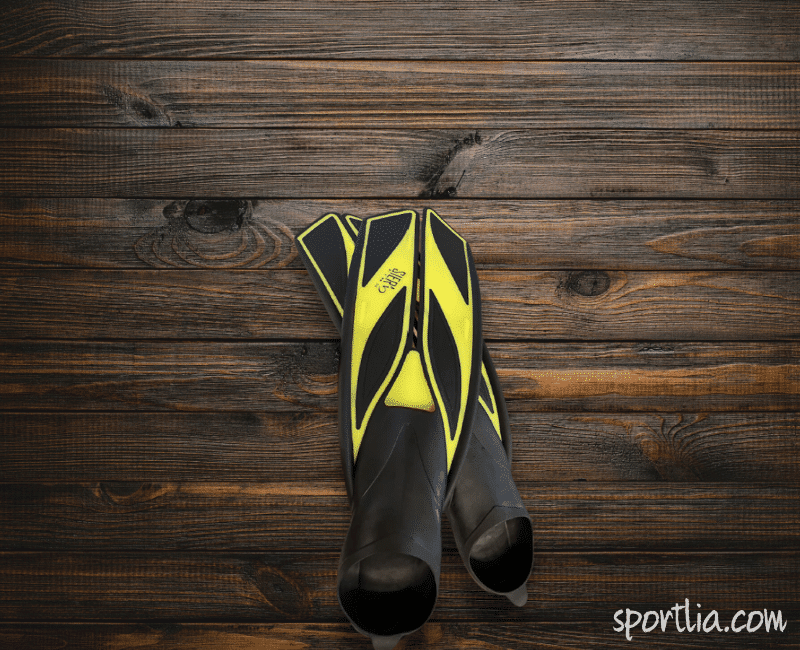Today, we will look at the 7 best scuba fins for beginners.

As a beginner, you may find it challenging to choose an excellent pair of fins for scuba diving because you have just started, and you have no idea about fins and their working systems. It is therefore vital to have a guide to assist you in your selection.
In order to stay on the safe side and explore the underworld of water, you should have the best scuba diving kit on your journey.
If you dive without proper training and equipment, you might encounter a lot of trouble.
Consequently, if you don’t choose the suitable apparatus for your diving, you will end up in a dangerous situation since you won’t get out of it.
And, scuba fins are also an essential tools to aid you in your scuba diving activities.
However, several fins are made for scuba divers whose working system is defined on the water environment level and how deep you will explore.
Here, I will guide you on choosing the best fins for scuba diving as a beginner.
Also, I will give you a brief introduction on how to purchase the best pair of scuba fins? And what factors to consider while buying scuba diving fins.
Before you jump into the selection section, I recommend you jump straight into the buying guide and read all the buying tips to understand the fin’s working structure, propulsion, comfort, blade types, and heel style.
Once you have some knowledge about scuba fins, it will help you in your selection.
Table of Contents
The 10 Best Scuba Diving Fins For Beginners
Here is a comparison table for the top 7 scuba fins for beginners;
| Image | Fins Name | Features | Price |
|---|---|---|---|
| 1.Cressi Scuba Diving Fins |
| Check On Amazon | |
| 2. Mares Quattro Scuba Fins |
| Check On Amazon | |
| 3. TUSA SF-22 dive fins |
| Check On Amazon | |
| 4. ScubaPro Nova |
| Check On Amazon | |
| 5. WACOOL Scuba Fins |
| Check On Amazon | |
| 6. SIER Fins |
| Check On Amazon | |
| 7. TUSA SF-15 Diving Fins |
| Check On Amazon |
Reviewing 7 Best Scuba Fins For Beginners In 2024
Here is a closer look at each of these scuba fins to uncover their capabilities, ease of use, and work.
1. Cressi Scuba Diving Fins – TOP PICK
- The Pro Light is a generous fin that provides exuberant...
- Blade made in dual material: strong polypropylene and...
- Full length side-rails help direct waterflow for...
Last update on 2024-08-06 / Affiliate links / Images from Amazon Product Advertising API
Cressi open-heel fins are the best scuba diving fins for beginners. As the blades are pretty long to match the way you dive.
High-quality material is used to make these fins, ensuring optimum performance.
The polypropylene and super soft elastomer are joined to bring lightweight fins to help you stabilize your body position in the water.
Cressi fins provide a generous fit with little to no effort, thanks to the open heel design.
I recommend open heels fins for beginners, as they are easy to put on and take off.
Therefore, if size matters to you, then Cressi should be your first choice for scuba diving since they are designed to give you a comfortable diving experience with minimum effort.
The Cressi scuba fins come with incredibly long blades that generate remarkable thrust.
These fins produce a pretty good amount of propulsion, which will enhance your scuba diving since you won’t have to exert as much effort.
It takes fewer kicks to generate more speed when using the long blades.
However, the short blade isn’t a good option, and I would always recommend going with a long blade as they allow you to generate more thrust and speed than short blades.
Apart from beast blades, Cressi has also integrated channel thrust technology into their blade designs, which means the blades channel water.

Furthermore, these fins feature a soft and anatomical foot pocket that activates your feet.
As far as divers are concerned, the Cressi is pretty intelligent. They have made the product from a combination of highly reactive polypropylene and elastomer material. Elastomer is included explicitly in their foot pocket for a more secure, snug fit.
Even though the foot pocket is made with great care, I recommend you wear booties because open heel fins can hurt your toe or ankle, which causes fatigue, cramps, and chaffing.
Also, booties are a must for divers because the temperature goes down as you go in-depth. That’s why they are used to keep your feet warm. Remember this when you are trying to buy open-heel fins for scuba diving.
Moreover, the Cressi fins are equipped with a quick-release buckle system that I recommend for beginners. Featuring an adjustable quick-release binding system with a strap, you can wear these fins within minutes.
Overall, Cressi is equipped with features that beginners need and want in their scuba diving activities. Where propulsion and efficiency are the keys, I suggest you try Cressi because they are a budget scuba fin and won’t burden your pocket.
Note: The size of Cressi scuba fins runs a bit long; therefore, it will require a lot of power to accomplish the best results. Your kick ratio will determine how fast you move. These fins require strong kick power to handle them. I recommend beginning slowly and gradually kicking more quickly once you start to feel the speed.
In addition, if you are going to purchase the Cressi open heel fins, do not use them without dive socks or boots. When you are a beginner, you should avoid using fins without water socks because this can result in blisters or cramps. To ensure your feet are safe and secure, I suggest purchasing a pair of booties (divers only need booties, not water socks).
2. Mares Quattro Scuba Fins – Editor’s Choice
- Non-Vented Fin
- Exceed the Established Performance of Traditional Model
- New Composite Materials, Optimize Efficiency
Last update on 2024-08-06 / Affiliate links / Images from Amazon Product Advertising API
Open heel Mares fins are another excellent option for scuba diving.
These are packed with enough power to let you explore the water world quietly.
Furthermore, Mares plus fins have long blades that can be used at any water depth.
You might be familiar with Mares if you have used diving gear before. They are pretty famous for designing scuba diving fins.
However, this time, we’ve seen a lot of improvement in their fin designs and materials structures.
In this new era, speed and efficiency are mandatory factors for scuba divers. Divers want something that can handle their kicks effortlessly.
Thus, Mares restyled the Avanti fins to make it a more competitive fin for today’s world.
The reconstruction of the old version brought many changes in the scuba fin design.
They have combined high-quality materials to bring you happiness and help you convert your energy into powerful kicks.

The Mares scuba fins are packed with bungee straps and designed to ensure your legs stay relaxed all through the dive session.
Also, the color of the fins makes a huge difference.
You can take the non-vented mares’ fins into account if you are looking for the best style of scuba diving fins since they are designed to outperform the traditional fin styles and optimized for higher propulsion.
Besides that, the bungee straps and long blades make these the ideal diving tool.
The bungee strap style is made from thicker materials to ensure a smoother fit. The material is reasonably thick, making it durable and robust.
Furthermore, Mares Avanti plus fins feature side rails to help you handle the water much more straightforwardly.
Therefore, if you are looking to speed up your diving journey and learn the dive techniques, then mares are great fins for beginners.
In short, the mares swim fin is a powerful package that kick-starts your scuba diving. If efficiency, speed, and thrust are your top priorities, Mares’ attractive fins will meet all of your needs.
3. TUSA SF-22 Open Heel Diving Fins – Premium Choice
- Powered by ForcElast Technology
- TUSA patented 20° Angled Blade Design (A.B.D.)
- Multi-compound foot pocket increases power transfer to...
Last update on 2024-08-06 / Affiliate links / Images from Amazon Product Advertising API
Have you ever heard of split fins?
Well, They’re not split fins, but they’ll give you an advantage in your diving due to their unique design and tiny holes on the blades that will help water escape. As a result, your legs will be less burdened.
Tusa Solla scuba diving fins have incredible features that manage water pressure to help you overcome obstacles.
If you are looking for futuristic scuba diving fins, you may be surprised by Tusa’s performance and stability.
They have used advanced materials for the construction of these unique pairs of diving fins.
The fins facilitate your flow because of the improved materials, and the blade design is conducive to strong currents.
So if you are swimming against a strong current, then these fins will provide superior support to your body, which is a good sign for beginners.
The Solla fins are designed to encounter high water pressure and help you escape from such a situation.
I know you are wondering why these are best for strong currents. Well, all thanks to their unique and flexible blades.
Tusa fins have long blades, but the best part is they have a tiny hole on the top area of the blade.
They work by passing out a small amount of water through them. Of course, this will be useful during your sessions.
In my experience, long blade fins are very difficult for a beginner to handle since they require a ton of kick power to move through the water.
So if you don’t have much strength in your legs, you may consider Split fins or Tusa vints pair of fins.
This way, you won’t need much power to generate much energy for each kick.
Furthermore, the Tusa scuba fins are equipped with an EZ quick-release straps system for quick and easy adjustments to your barefoot with zero effort.
For beginners, I recommend the straps and buckle system since you can easily adjust the tightness of the foot pocket through the straps to make it a more snug fit. So with the straps system, you won’t face sizing issues.
As for their ease of wear and removal is a relatively simple process that doesn’t require rocket science.
When you think about efficiency and propulsion, you have to keep in mind the materials used in the fins.
Tusa long blade fins are constructed from a soft elastomer material that lasts longer and causes the fin’s foot pocket to be smooth and the blades to be highly flexible.
These fins feature angle binding technology, which means the blades are bound at 20 degrees from the blade area. With this, you will be able to handle strong currents reasonably well.
Further, this type of fin will have a significant effect on your scuba diving speed. Compared to other scuba diving fins, they require significantly less kick power.
The Tusa Solla open heel fins are undoubtedly the best scuba fins for beginners because of the angled blade design and the side rails on the blade side that completely transform your scuba diving session into a comfortable one.
4. ScubaPro Nova – Travel Size Fins
- The fin’s unique articulated design enables the...
- Made of a space-age Monprene elastomer, the Seawing...
- SCUBAPRO’s Pivot Control Technology maintains the...
Last update on 2024-08-06 / Affiliate links / Images from Amazon Product Advertising API
The Scuba Pro Seawing fins are the entry-level scuba diving fins for beginners.
The design of nova fins is different from other scuba diving fins listed in our list. There is a reason why ScubaPro has made so much improvement in its history.
The ScubaPro is a realistic fin constructed for scuba diving to help you learn diving techniques to explore underwater.
The fins feature unique blades, which makes these fins quite interesting for scuba divers.
The blades are designed to allow water to pass through the joint area between the foot pocket and the blades; This will increase thrust and reduce drag.
It will increase your scuba diving speed since your legs will not have to work as hard, and you can keep kicking constantly.
The water which passes out from the system will make your swimming easier. These fins work on the principle of split fins but are less powerful when it comes to propulsion and hardness.
The flexible joint is constructed from high-quality materials to keep the integrity of the fins and avoid breakage.
The joint area of the fins does not affect your speed. In fact, it will help you generate more thrust than other traditional scuba diving fins.
The purpose of this pivot design is to ensure excellent results during diving sessions.
Also, you won’t feel a lot of pressure while kicking due to the medium-sized blades. I know how hard it is to kick in long blade fins.
You can take the medium size blade into account for beginners because it will give less stress to your legs. And if you need more thrust without much drag, ScubaPro is a good fit for you.
This will help you save energy during your session and keep your focus on your goals.
The Scubapro is also packed with bungee straps style, enabling you to adjust the heel straps and size of the foot pocket according to your feet size.
As I already mentioned, the straps system will be a good choice if you have no idea how to choose the correct size for your diving fins.
Furthermore, the foot pocket and blades are joined together to give the fins a unique look, affecting your swim style.
The foot pocket with extended heel style transmits much power to the blades to overcome hurdles in your way.
Due to the unique structure, the fins reduce the strain on the legs and are stable and consistent.
Further, these scuba diving fins are heavy as they weigh around 3.5 pounds, so that they might seem a bit of a burden on your legs, but to be honest, they will easily go in the water since there isn’t that much power required to handle them.
In this way, you will be able to move quickly against the current without worrying about your body positioning.
Also, keep in mind that these fins are only suitable for shallow (about 30 feet or less) water. They are not ideal for intense deep water, especially for beginners.
5. WACOOL Long Blade Fins – Best For Propulsion
- Long blade with open heel adjustable straps. Available...
- Features a soft and comfortable foot pocket and...
- Blade extends from the top of the foot pocket to...
Last update on 2024-08-06 / Affiliate links / Images from Amazon Product Advertising API
Wacool scuba fins are engineered to increase maneuverability and reduce stress on your legs.
These scuba diving fins are a great package to level up your expertise and learn some techniques securely and efficiently.
If you are looking for lightweight scuba diving fins that give a real-time response to your powerful kicks, then Wacool is your best choice for scuba diving.
Fins like these are designed to provide you with effortless handling without tiring you out.
What makes the Wacool remarkable is its responsive blades and soft open-heel foot pocket.
The blades are not too long, but they are enough for beginners to start their scuba journey.
Although the foot pocket is equipped with an adjustable strap system, your feet will be more accessible than ever.
All you have to do is release the buckle system and insert your foot, then pull off the straps and turn off the clip and you are ready to go.
The ease of wearing these fins will save you time, and they are beneficial if you plan to share them with friends and family.
There are adjustable systems for the foot pocket, so you won’t have trouble finding the correct size for your feet.
The Wacool scuba fins accept almost all foot sizes, whether wide or narrow; you will be okay with self-adjustment.
Additionally, the foot pocket is super soft and comfortable for beginners as well as professionals.
The wacool adjustable diving fins are designed to ensure a snug fit and prevent cramps, chafes, and blisters. Without these problems, diving will be more enjoyable.
However, I always recommend that you must use water booties with Adjustable straps fins.Otherwise, you will feel disturbed, and it might hurt your toe or feet, which will cause you problems.
Moreover, these fins are made from highly responsive and lightweight, reactive polypropylene materials that generate more thrust and power.
This will surely activate your body to swim faster and harder by kicking effectively.
The performance will depend on how hard you kick, but the blades feature 90-degree bending capability.
These fins also comply with standard American product checks guidelines, so they have included PP and TPR materials further to enhance the kicking power and toughness of the blades.
I know you might be a little bit pissed off after hearing the 90-degree binding flexibility.
But don’t worry, the blades are not too soft nor too hard. Binding is quite reasonable for beginners, and in fact, they are beneficial for scuba divers to generate more propulsion, speed, and thrust.
Almost everyone wants their fins to be flexible and bind enough to move up in water quickly.
The Wacool is the perfect gift for beginners and travelers because it comes with a handy mesh bag.
The bag is used for storing the fins so that you can carry them to your favorite places.
Now, if you are looking for the best scuba fins for beginners as a traveler, in that case, Wacool is the best option for you because it gives you incredible power to accelerate your legs to operate faster than ever.
Their medium size blades will strengthen your swimming as well as enhance your kicking technique. They are beneficial for beginners because they will teach your legs that the harder you kick, the better results you will receive.
Please note that the fins don’t fit over a neoprene boot, but they will fit over dive socks. So if you love to wear dive boots with scuba fins, then forget about Wacool.
6. SIER FINS – Budget Pick
- CUT THROUGH WATER with the agility of a shark with...
- LESS SURFACE RESISTANCE results from water moving...
- LONGER-LASTING full-pocket long fins completely...
Last update on 2024-08-06 / Affiliate links / Images from Amazon Product Advertising API
Sier fins are the best diving gear for beginners to accelerate their scuba diving and kick-start their journey.
For the first time in this list, I am going to throw light on the split fins. I explain why split fins tend to perform better for scuba diving.
Beginners will always be concerned about water pressure and resistance.
That’s true; you will go against strong currents while scuba diving.
However, there is a solution to win in such cases. That is to use split fins.
The split fins provide less surface resistance by moving the water through split areas between the blades.
The blades are divided in the middle, which will allow water to pass out easily.
By using Split fins, your legs will experience less pressure, and your kicks will operate at an average speed.
With regular fins, you have to use a lot of energy to perform strong kicks to move on.
On the other hand, split fins require less energy, and they do not need much power for each stroke.
The split fins will help reduce water drag, which will indirectly benefit you in reducing cramps and ankle strains caused mainly by paddle fins (the regular fins with standard blades).
Therefore, if you do not have substantial power in your kicks, split fins would be a great option.
Nowadays, there are many split fins on the market. They are designed from a variety of materials and quite popular among scuba divers.

I like Seir fins for scuba diving because they give you a sense of safety in the water.
The reason I love their design is because of the super long blades and full-pocket heel style.
Yes, these are the first split fins in our list which come with a Full pocket.
However, keep in mind that these fins don’t feature an adjustable strap or a quick-release buckle system.
It’s a super simple open heel (full-pocket) fin with a pretty good amount of space to be worn with or without socks.
However, there is no need to get neoprene water socks with full-pocket fins.
But if you want to double the comfort and improve softness to keep your feet comfortable, make sure you size up to choose a slightly higher size.
The Seir fins claim to generate a cut-through water experience with versatile use of split fins structure.
They aren’t wrong regarding speed and creating lift with each stroke. Seir fins win to be the best scuba diving fins for a starter.
They are designed to overcome pressure problems and give you even more propulsion to feel the speed.
The Sier fins are equipped with super solid blades and vertical stabilizing blushes to help water flow smoothly over them.
Thus, you will be fine when you are under high pressure because it won’t tire your legs so early, and you will be relaxed to get out of it.
Last but not least, I will only recommend split fins for super low current.
They will not give good results against very strong currents. However, they operate pretty well in calm lakes, rivers, and open water area.
7. TUSA SF-15 Open Heel Fins – Most Comfortable
- Three material design for increased performance...
- Patented 27 degree Angled Blade Design
- Enhanced propeller-fin technology optimizes efficiency
Last update on 2024-08-06 / Affiliate links / Images from Amazon Product Advertising API
Tusa is another best scuba diving fin for beginners, which is expensive yet super powerful to boost your scuba diving.
It might surprise you to know that these fins are also called split fins.
However, the design is unique and different from other split fins which I have seen so far.
These Tusa fins feature narrow split lines in the middle of the blades that do not extend too far but are still below the foot pocket area.
You can expect awesome performance and better stability compared to other split fins.
Tusa has been leading the industry, and years of experience have pushed them to construct something unique for scuba divers.
That’s why we have their unique split fins to refine the scuba diving activities ultimately.
These swim fins are designed with a combination of three robust materials to ensure high-quality diving fins.
Also, these split fins are equipped with a multi-compound combination, so you don’t have to worry about wear and tear.
Furthermore, the design has been improved to generate optimal performance, and the length of the blade has been extended compared to earlier version Tusa swim fins.
Tusa scuba diving fins are designed to generate and incorporate the propeller needed. It ensures you get the maximum benefit out of every kick.
Furthermore, these fins feature an angled blade design, which allows the blade and foot pocket joint at 27 degrees to generate powerful effects during your kicking cycle.
The angle technology makes it possible for the fins to act as propellers.
The fins create a beautiful shark-style shape to generate propulsion and increase efficiency while reducing drag.
Are you a fan of Buckle straps? Well, you have already seen some excellent scuba diving fins that come with straps and quick-release buckle systems.
As I specified at the beginning of this review guide, buckle straps are easier to use for beginners because you can adjust the tightness of your fins within seconds.
So, if you’re interested in Tusa split due to their high output level with minimal effort and unique combination.
Then let me tell you that these fins come with EZ straps and a quick-release buckle system, enabling you to make smaller and minor adjustments to your feet with absolutely zero effort.
You can adjust the tightness while wearing them. To do so, adjust the tightness of the straps, and they will be a snug fit.
I like the straps adjustment system because there are two buttons on each side.
So basically, they are two release buttons on both sides of the straps. Therefore, you will find it easy to use.
However, I would advise you to wear neoprene socks with open-heel (strap buckle system) foot pockets; otherwise, they will hurt your feet and cause blisters or chafing. Therefore, you should always be cautious.
How To Choose The Best Scuba Fins For Beginners
Scuba divers always need firmer fins compared to recreational swimmers.
Because scuba divers need propulsion and flexibility to handle current, you will meet challenges while diving, and you will have to deal with water propulsion and strong current.
The situation can be different depending on the water flow and area.
However, for beginners and professionals, their blades of scuba diving fins must be slightly lengthier than other typical snorkel or swimming fins because the longer the blade, the more robust results and strength you will get with each stroke.
Therefore, it’s essential to consider the following factors when buying the best scuba diving fins for beginners.
It is crucial to know your requirements before choosing a fin because all fins aren’t suitable for scuba diving. So let’s know the features of fins to understand what works for scuba beginners.
Types Of Scuba Fins – Blade Style
Scuba fins come in a variety of blade styles. Their propulsion and strength in water will vary.
The blade style, however, affects the amount of thrust and power created with each kick. All these factors depend on the blade style.
There are different types of blade styles, but these two are famous for scuba diving.
Paddle Blade
Paddle blades are also known as non-vented blades.
Divers most commonly use them because they are flat and simple to use.
The paddle fins offer overall great strength and performance.
I don’t recommend paddle blade fins for beginners because they are non-vented, which means it does not have holes or channels to pass out water.
On one side, paddle fins are beneficial for beginners if you are concerned with learning diving techniques, building leg muscle, improving ankle flexibility, and building stamina. So you can consider paddle fins if you need to develop your strength.
Therefore, you will need strong kicks to achieve a good amount of speed and create more resistance.
As you know, beginners like you don’t have much stamina and leg power to handle strong current and high pressure of water.
The results might be good, but running harder and harder will indirectly reduce your stamina, meaning you’ll tire quickly.
Therefore, the paddle fins’ downside is they require strong kicks, which can exhaust you quickly.
However, paddle fins do have a lot of advantages when it comes to propulsion and flexibility.
They are sometimes equipped with side-rails and flex points, determining how much power you will need to handle these blades.
Split Blades
As the name suggests, Splits fins are split between the middle, which divides the blades in two and looks like they are two different joined blades.
Split fins can be an excellent choice for scuba divers because they reduce water drag and offer a significant amount of power.
They act as a propeller which helps you in pushing forward with less effort.
Split fins require less kick power as compared to paddle fins. So if your leg strength and power aren’t that good (I know beginners don’t have more muscular leg strength and power, but as you practice, it will be built), I recommend you go with split fins.
It will not just help you build leg muscle but improve ankle flexibility and stamina.
If you have undergone ankle surgery or have pain in your legs that prevents you from diving, try split fins.
They are designed for short flutter kicks. However, you must be monitored by a guide or professional while diving as a beginner.
It is also important to note that split fins will not work against strong currents.
For that, I will only recommend Channel Fins (also called vents fins, they have small; usually two tiny holes in the upper side of blades, allowing the water to cross or pass out, which will put less strain on your legs) or paddle fins.
Blade Length
The blade length determines the fin’s performance. The size of the blades decides how they will perform.
The blade length plays a vital role in your scuba diving speed and buoyancy.
Every diver must master the skill of buoyancy, and that’s only possible by choosing the correct length for scuba diving fins.
The blade length is divided into three sizes. However, each of these will work indifferently in swimming conditions, and it depends on the environment.
The three types of blade length are following;
Long Blade
The longer the blades, the more forward propulsion. They give a boost to your scuba diving, but they require more effort with each stroke.
Long blades fins work best for beginners diving in the open ocean.
If you have just started learning scuba diving, you may consider long blades because they are pretty good for flutter kicks and silent water.
So I will recommend long blades as well as medium blade fins for beginners scuba divers.
However, if you are a traveler, make sure your bag is big enough to store them because they require enough space in your backpack.
Medium Blade
Medium size blades are also a great pair of scuba diving fins for travelers because they don’t require as much space as longer blades do.
They are a bit longer than short blades but shorter than long blades, meaning these lie in the middle of short and long blade fins.
However, they don’t produce much power compared to longer blades, but you will be fine because they don’t require as much effort as longer blades do.
If you think your legs do not have adequate power and strength to handle large blade fins, then medium blades are the way to go.
These require significantly less kick-powers and provide a pretty good amount of boost to your diving. Also, you can improve your frog and flutter-kicking techniques through medium blade size.
Short Blade
Short blades fins will help you quickly propel a strong current.
If you prefer short flutter kicking cycles and frog kicks, then short blade fins tend to play better for scuba divers.
Short blade fins require plenty of kicks to move forward, so they are best for training. This will indirectly build your leg muscles, improve ankle flexibility, and strengthen your stamina.
However, I don’t recommend short blade fins for beginners because they require a lot of higher kick rates, and you might lose control of buoyancy.
Since you will be kicking at a higher rate, you will tire so quickly.
Also, if you are going with short blades (I don’t recommend), make sure not to go into depth because they will make you tired due to frequent kicks.
Heel Style
Fins heel style or foot pocket is an essential part of each swim fin.
When deciding on heel styles, you have to be extremely cautious.
Your journey will be difficult if you pick up the wrong foot pocket. Because if your foot pocket isn’t compatible, they will hurt your toe, ankle, and barefoot, leading to severe issues such as causing you cramps, chafing, and blisters.
It’s essential to choose the fins with a comfortable foot pocket.
To better understand which heel style is ideal for scuba diving, let’s examine them in detail.
It is further divided into two types.
Open Heel
Open heel fins are best for scuba diving. It has an open heel area where your feet can be placed, and the tightness can be adjusted by using adjustable straps.
Open heel fins are equipped with adjustable straps and a quick-release buckle system which you can use to adjust the tightness of the foot pocket to make it fit on your feet.
Open heel fins are ideal for beginners and professionals since you will experience a drop in water temperature when you go deep down.
In this case, you MUST wear water booties to keep your feet warm since Open heel fins are adjustable toward a wide range of sizes to be worn over booties.
Additionally, when you don’t need your fins, you can wear booties for walking in an area protected from shore diving and put on fins once you reach your destination.
So open heel fins are always the best scuba fins for beginners as well as professionals.
Closed Heel (Full-foot)
Full foot fins are mainly used for snorkeling and taking laps in the warm water.
When you are swimming in warm water, you will rarely need booties and neoprene socks.
Therefore, if you don’t need booties, then you don’t need close heel fins.
Closed-heel fins are recommended for surface swimming. Since you are going scuba diving, they don’t seem cool.
However, a minority of divers still prefer full-foot fins because they are lighter and cheaper.
Even if they are diving in cold water, you might notice them wearing 3 or 5 mm neoprene socks to keep their feet warm.
However, they are limited to certain areas. Once you escape from there, neoprene socks won’t work.
That’s why I don’t recommend closed-heel fins for scuba diving.
Also, there are many issues with sizing; you might end up (they are not for scuba diving) with the wrong size since there are no adjustable straps to adjust the foot pocket size according to your barefoot.
Size
SO, What size fins do you need for scuba diving?
Unfortunately, I can’t tell you what size scuba fins fit you.
Here, you have to do a little homework to find the correct fins size.
Actually, choosing the full-foot pocket fins will be pretty easy because they sometimes come in the same size as your shoe. So your shoe size will guide you in selecting the correct size for the full-foot fins.
Since I only recommend open-heel fins for beginners because you can use them with dive boots.
It’s hard to choose the correct size because each swim fin comes with a different sizing guide.
For example, Cressi medium-size fins will have a different sizing measurement guide than Mares medium-size fins.
That’s why, whenever you are shopping for the best scuba diving fins for beginners, then make sure to find out the sizing chart on the manufacturer’s website and calculate your foot size as directed by them.
Thus, it will land you on choosing the perfect size fins for your scuba diving.
While writing this review, I came across an article about return rates on invespcro.
They recently calculated that 35% of their customers return products because of the wrong size.
Also, a shoe retailer, Zappos, revealed that 30% of their products are returned because of the wrong size. So sizing is a big issue for every shoe type product.
Your choice of the appropriate size is in your hands. The sizing guideline on the manufacture page makes it easy to figure out.
Comfort
If your diving fins aren’t comfortable, then they aren’t even workable.
You can feel the comfort in their blades and foot pocket design.
In this, you have to determine the type of materials used in the fins.
Rubber and thermoplastic materials are always flexible and more comfortable.
Most swim fins are made with a combination of two or three types of materials.
These manufacturers use soft rubber or plastic materials in their foot pockets to make the foot pocket comfortable (you can double the comfort by using booties or neoprene socks). Another type of material in the blades to make the blade flexible and elastic.
Also, please pay attention to the foot pocket, since comfort is found there. If you have a comfortable foot pocket, you will have a better diving journey. In contrast, if they aren’t, they can hurt your feet badly.
Propulsion
Scuba divers take propulsion seriously because it determines their thrust and kicks power.
Your fins blade-style determines the propulsion level. They must be propelled to help you maintain a stabilized position underwater.
Therefore, the propulsion will be determined by the length of your blades. The longer the blades, the more power they will exert.
Short fins have less propulsion as compared to longer or medium blade fins. That’s why longer blade fins are considered best for scuba diving.
Price
There is a common misconception that expensive products are of better quality.
That’s not true, the product’s price is determined by demand and supply, and sometimes the marketers play tricks on you. They can raise the product price to make you feel these are the best because their price is high.
Expensive products are indeed made with extensive raw materials and perform better than cheap materials.
I am talking about overpriced products which don’t even serve the purpose for which they are designed.
The scuba diving fins price ranges from $40 to $300.
There are some outstanding scuba diving fins in the range of $100 to $200.
However, in the end, the comfort, buoyancy, propulsion, self-contained and materials of the fins play an essential role in your scuba diving.
My list contains products for different levels of scuba diving.
I have also labeled the scuba diving fins based on your budget level. So it will be easy for you to choose the best scuba diving fins for beginners.
Let me tell you a quick fact, Tusa fins will always be an expensive option, but they are highly beneficial for beginners because of their quality and unique features.
However, please don’t ignore the entry-level fins cressi and Mares; they can kick-start your scuba diving journey.
Frequently Asked Questions (FAQs)
How did I select the best scuba fins for beginners?
While searching for the best scuba diving fins for beginners, I kept the buyer’s guide in mind.
Apart from that, experience and testing are what make you find the best diving fins. I have used some of the above scuba fins, and they have always offered excellent results.
In comparison, other fins are selected after looking into buyer reviews, recommendations and based on testing in different sources. Once the fins comply and pass the extensive tests, I picked them.
What is the difference between snorkeling fins and scuba fins?
Scuba fins are heavier and larger than snorkel fins because divers need more thrust and propulsion with each stroke than snorkel fins.
The longer the blades, the better the propulsion and thrust will be generated. That’s why scuba fins will have longer blades than snorkel fins.
Also, scuba divers need Open Heels fins style because they need to wear booties for thermal protection.
On the other hand, you can use any heel style for snorkel fins; you can even use snorkel fins without socks because they are primarily used in warm water.
Are there any scuba fins for wide feet?
Almost all open heel fins accept wide and regular foot sizes because they come with an adjustable strap and quick-release buckle that can be adjusted to tighten the foot pocket to fit securely.
Therefore, they fit all types of feet, and you will be comfortable wearing them whether you have wide feet or normal feet.
Can you use scuba fins for snorkeling?
No, snorkelers do not require much thrust or propulsion. Their swimming skills are limited to a certain amount of water depth.
Snorkelers mostly swim on the surface of the water. That’s why they are trained to handle less pressure and efficiency.
However, scuba divers swim in the depth of the water; that’s why they will encounter more pressure underwater. Thus, scuba fins need to be longer and bulkier to handle the situation, and snorkel fins tend to be shorter and lightweight.
Conclusion
I am well aware of the struggle and the hassle of finding the best scuba fins for beginners.
As a beginner like you, choosing a pair of diving fins is always challenging since hundreds of choices on the market with different features might confuse you about what works and what doesn’t.
Therefore, I don’t want you to face the same hurdle that I did in my time. I have created a simple checklist of different swim fins to help you select your first pair of scuba diving fins in a minute.
Make sure you know how you intend to use your scuba fins. Once you know your requirements, such as proficiency, pressure, propulsion, and kick power, you should be good to go.
However, if you follow my buying guide for picking scuba fins for yourself or your friend, you will never go wrong.
I know it’s hard to find the correct size as a starter, but do a little homework before purchasing one.
I hope this guide helped you in purchasing your first pair of scuba fins.
If you have any questions or suggestions, please feel free to ask. I will be happy to answer.
I would also like to know about your first experience as a diver and what fins you used or will use.
As always, best of luck!





